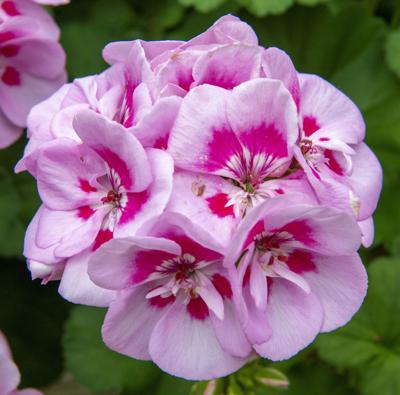My husband and I planted geraniums in our front garden, which is in full sun most of the day. They were doing well until about two weeks ago, and now they are looking wilted and very thin like they are about to die. We are not sure if it's the heat causing this or too much rain. We don't know if we should cut them back, pull them up or leave them alone. We want them to come back every year, which is the reason we planted them to begin with. Can you tell me what might be causing them to look this way and what we need to do, if anything, to help them? — Stephanie Vlosich
Although geraniums are technically perennials, you should not consider them reliable, long-lived perennials in our climate.
What you are seeing is the geraniums’ strong dislike for our intensely hot, humid summers. At best, they languish in the heat, lose vigor, bloom less, look leggy, foliage is pale, etc. At worst, these plants become susceptible to root and stem rot caused by fungus during the hot, wet weather of July and August and succumb to these diseases and die.
If they survive the summer, they will revive as the weather cools in the fall. Cut them back in September to encourage the plants to be fuller and more attractive as they grow into the fall season. You’ll just have to tolerate how they look until fall. Be careful not to water the bed excessively (there’s nothing you can do about rain), and do not fertilize the geraniums until September or October.
Geraniums are fairly hardy and will easily survive temperatures in the mid or even low 20s. This is why we generally use them as cool-season bedding plants. We plant them in the fall, enjoy the flowers through the fall, winter, spring and early summer and pull them out and replace them with summer bedding plants in May or early June.
They are generally replaced because we want the flower bed to stay attractive through the summer, and we know that even if they survive, we will be looking at two to three months of summer “downtime” when the geraniums will not make a positive contribution to the beauty of the garden.
On rare occasions when the temperatures dip into the teens during winter, the plants may be badly damaged or killed. Again, they are not a reliable long-lived perennial here.
I have been growing orange and satsuma trees for about five years. Friends who have been growing citrus for quite a while tell me that any branch above the graft that has thorns will not produce fruit and should be cut off. If this is true, when should I trim my branches with thorns? — Gary Delacroix
Despite their experience, your friends are wrong. Thorns are a natural part of citrus trees. Although the citrus cultivars we commonly grow have been selected to minimize thorniness, when a citrus tree, particularly a young one, sends out a strong-growing vigorous shoot, the shoots are often quite thorny. This is natural. The branch is still part of the tree and in time will stop growing vigorously and will bloom and set fruit.
The fruit the thorny branch produces will be just as good as fruit from less-thorny branches. Sometimes these vigorous shoots are cut back somewhat to keep the shape of the tree more attractive and control the rate of increase in size. You may do this any time during the summer, but don’t feel like you have to.
What you should always cut off are shoots from near ground level below the graft. These growths are generally very thorny and perhaps that is what your friends are thinking of. Sprouts from below the graft should be cut off as soon as they are noticed.
My pears are turning yellow with a rosy tint. My books say not to harvest until late September or early October. I am in Zone 8 near Folsom. Any info is greatly appreciated. — Rachael
Your tree knows better when it will ripen its fruit than any book. Believe your tree, not your books. The colors you describe indicate that the fruit are reaching ripeness. In south Louisiana, late July through early September is when pears ripen, with August generally being prime season.






